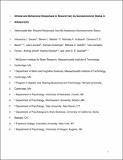| dc.contributor.author | Decker, Alexandra L | |
| dc.contributor.author | Meisler, Steven L. | |
| dc.contributor.author | Hubbard, Nicholas A. | |
| dc.contributor.author | Bauer, Clemens C.C. | |
| dc.contributor.author | Leonard, Julia | |
| dc.contributor.author | Grotzinger, Hannah | |
| dc.contributor.author | Giebler, Melissa A. | |
| dc.contributor.author | Torres, Yesi Camacho | |
| dc.contributor.author | Imhof, Andrea | |
| dc.contributor.author | Romeo, Rachel | |
| dc.contributor.author | Gabrieli, John D. E. | |
| dc.date.accessioned | 2024-01-22T21:07:19Z | |
| dc.date.available | 2024-01-22T21:07:19Z | |
| dc.date.issued | 2024-01-22 | |
| dc.identifier.issn | 1529-2401 | |
| dc.identifier.uri | https://hdl.handle.net/1721.1/153394 | |
| dc.description.abstract | Disparities in socioeconomic status (SES) lead to unequal access to financial and social support. These disparities are believed to influence reward sensitivity, which in turn, are hypothesized to shape how individuals respond to and pursue rewarding experiences. However, surprisingly little is known about how SES shapes reward sensitivity in adolescence. Here we investigated how SES influenced adolescent responses to reward, both in behavior and the striatum–a brain region that is highly sensitive to reward. We examined responses to both immediate reward (tracked by phasic dopamine) and average reward rate fluctuations (tracked by tonic dopamine) as these distinct signals independently shape learning and motivation. Adolescents (n=114; 12-14 years; 58 female) performed a gambling task during functional magnetic resonance imaging. We manipulated trial-by-trial reward and loss outcomes, leading to fluctuations between periods of reward scarcity and abundance. We found that a higher reward rate hastened behavioral responses, and increased guess switching, consistent with the idea that reward abundance increases response vigor and exploration. Moreover, immediate reward reinforced previously rewarding decisions (win-stay, lose-switch) and slowed responses (post-reward pausing), particularly when rewards were scarce. Notably, lower-SES adolescents slowed down less after rare rewards than higher-SES adolescents. In the brain, striatal activations covaried with the average reward rate across time, and showed greater activations during rewarding blocks. However, these striatal effects were diminished in lower-SES adolescents. These findings show that the striatum tracks reward rate fluctuations, which shape decisions and motivation. Moreover, lower SES appears to attenuate reward-driven behavioral and brain responses.
Significance Statement: Lower socioeconomic status (SES) is associated with reduced access to resources and opportunities. Such disparities may shape reward sensitivity, which in turn, could influence how individuals respond to and pursue rewarding experiences. Here, we show that lower-SES adolescents display reduced reward sensitivity in the brain and behavior. The striatum–a brain region that is highly sensitive to reward–showed greater activations during periods of high reward and tracked fluctuations between reward-rich and reward-scarce task phases. However, lower SES correlated with smaller reward-driven striatal responses, and reduced response slowing after rare rewards. These findings link lower SES to reduced reward responses, which could trigger a cycle of reduced reward pursuit, leading to fewer positive experiences, which could further diminish reward sensitivity. | en_US |
| dc.language.iso | en_US | |
| dc.relation.isversionof | https://doi.org/10.1523/JNEUROSCI.1633-23.2023 | |
| dc.rights | Creative Commons Attribution-Noncommercial-Share Alike | en_US |
| dc.rights.uri | http://creativecommons.org/licenses/by-nc-sa/4.0/ | en_US |
| dc.source | MIT News Office | en_US |
| dc.title | Striatal and Behavioral Responses to Reward Vary by Socioeconomic Status in Adolescents | en_US |
| dc.type | Article | en_US |
| dc.identifier.citation | Alexandra L. Decker, Steven L. Meisler, Nicholas A. Hubbard, Clemens C.C. Bauer, Julia Leonard, Hannah Grotzinger, Melissa A. Giebler, Yesi Camacho Torres, Andrea Imhof, Rachel Romeo, John D. E. Gabrieli. Journal of Neuroscience 22 January 2024, e1633232023. | en_US |
| dc.contributor.department | Massachusetts Institute of Technology. Department of Brain and Cognitive Sciences | en_US |
| dc.relation.journal | Journal of Neuroscience | en_US |
| dc.eprint.version | Author's final manuscript | en_US |
| dc.type.uri | http://purl.org/eprint/type/JournalArticle | en_US |
| eprint.status | http://purl.org/eprint/status/PeerReviewed | en_US |
| dspace.date.submission | 2024-01-22T20:50:36Z | |
| mit.license | OPEN_ACCESS_POLICY | |
| mit.metadata.status | Authority Work and Publication Information Needed | en_US |
